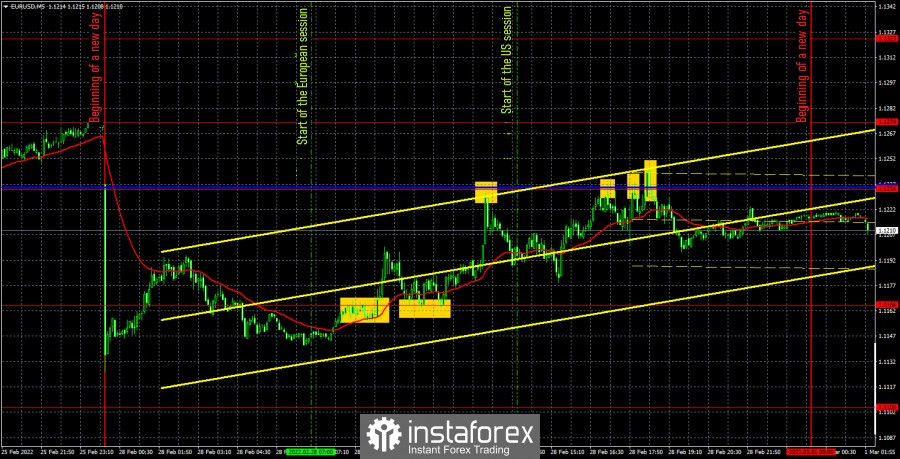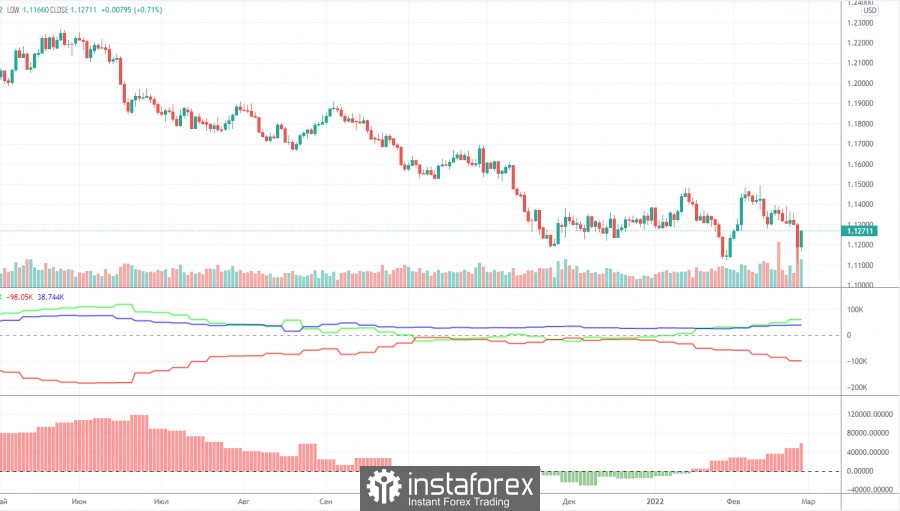

The EUR/USD pair, as it might seem, grew during the first trading day of the week. If not for the night fall, during which about 150 points were lost. The pair began to fall immediately for half an hour and went all the way down at the opening of trading. This was due to the strong geopolitical background that was on the weekend and which the market did not have the opportunity to work out. However, the pair began to recover at the European trading session and, in principle, was engaged in this activity throughout the day. Therefore, all trading signals were formed in the conditions of an intraday upward trend. There was no important macroeconomics or foundation during Monday. The first stage of negotiations took place between Ukraine and Russia, which did not yield any results.
Now as for trading signals. The first one - to buy - was formed when the price broke the 1.1166 level from below. The pair went up a short distance, then returned to the level of 1.1166, bounced off it and formed a second buy signal. Traders received zero profit on the first trade, as it closed at 0 for a Stop Loss at breakeven. It was possible to earn about 40 points on the second deal, because the price reached the critical line (almost). Short positions should have been opened at the signal of a rebound from the level of 1.1234, but this time it was not possible to reach the target level of 1.1166. Therefore, if traders manually closed this transaction, they made a profit, if not, then it closed at breakeven. There were three more bounces from the 1.1234 level. The first of these sell signals could be worked out, but the next two could not. Traders also received zero profit on Stop Loss for the only open trade on these signals.
COT report:
The new Commitment of Traders (COT) report, which was released on Friday, showed a new strengthening of the bullish mood among professional traders. This time, the "non-commercial" group closed about 17,000 contracts for short positions on euros and 5,500 long positions. Thus, the net position increased by 12,000, which is clearly visible on the second indicator in the chart above. The total number of long positions exceeds the number of short positions by 60,000, so now we can really say that a new upward trend is beginning to form. It would be possible to say, if not for one "but". The European currency is not growing. It does not rise even at a time when there seem to be "corrective" grounds for this. Recall that the euro currency has been getting cheaper in one way or another for 14 months. It does not grow even when the participants of the foreign exchange market themselves increase their long positions. It seems that geopolitics really remains in the foreground, so COT reports in some way lose their significance. Remember, when the Federal Reserve was actively pumping its economy with dollars, the data from the COT reports also did not always coincide with the trend in the market itself. This was because the money supply in the US was growing very fast, so it was not always important what actions the players in the market were taking. The "Fed factor" was more important. And now the factor of geopolitics is more important.
We recommend to familiarize yourself with:Overview of the EUR/USD pair. March 1. The markets experienced a shock. It's time to calm down and return to the usual trading mode.
Overview of the GBP/USD pair. March 1. The British pound also got into a "storm" on Monday. Boris Johnson proposes to tighten sanctions against Russia.
Forecast and trading signals for GBP/USD on March 1. Detailed analysis of the movement of the pair and trading transactions.
EUR/USD 1HThere is a downward trend on the hourly timeframe. However, it persists, of course, due to the strong geopolitical background that supports the dollar, and not because the market is now eager to get rid of the euro and buy dollars. Nevertheless, a fall in any case remains the most likely development of events. We allocate the following levels for trading on Tuesday – 1.0990, 1.1105, 1.1166, 1.1234, 1.1274, 1.1321, 1.1391, as well as the Senkou Span B (1.1251) and Kijun-sen (1.232) lines. There are also support and resistance levels, but no signals will be formed near them. The lines of the Ichimoku indicator may change their position during the day, which should be taken into account when searching for trading signals. Signals can be "bounces" and "breakthrough" levels - extremes and lines. Do not forget about placing a Stop Loss order at breakeven if the price went in the right direction of 15 points. This will protect you against possible losses if the signal turns out to be false. Another speech by European Central Bank President Christine Lagarde will take place in the European Union on March 1. It is unlikely that it will become more informative than all the last ones. Business activity indices in the manufacturing sectors will also be published in the United States and in the EU. These data are also not important now and are unlikely to attract the attention of traders.
Explanations for the chart:Support and Resistance Levels are the levels that serve as targets when buying or selling the pair. You can place Take Profit near these levels.
Kijun-sen and Senkou Span B lines are lines of the Ichimoku indicator transferred to the hourly timeframe from the 4-hour one.
Support and resistance areas are areas from which the price has repeatedly rebounded off.
Yellow lines are trend lines, trend channels and any other technical patterns.
Indicator 1 on the COT charts is the size of the net position of each category of traders.
Indicator 2 on the COT charts is the size of the net position for the non-commercial group.